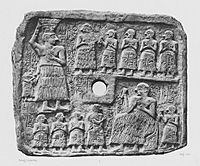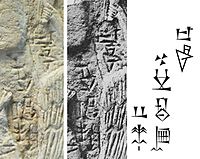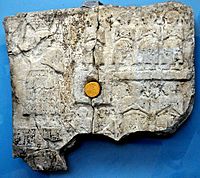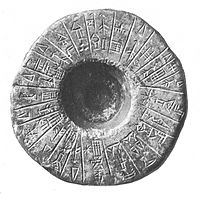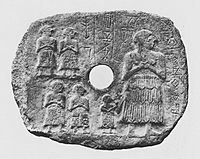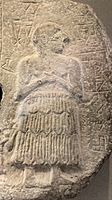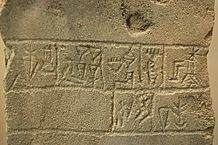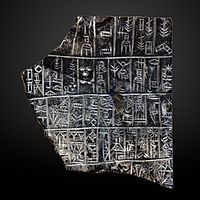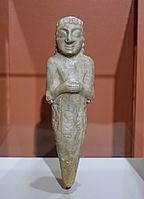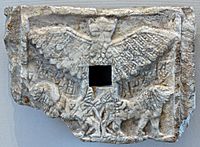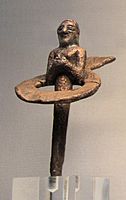Ur-Nanshe facts for kids
Quick facts for kids Ur-Nanshe𒌨𒀭𒀏 |
|
|---|---|
| King of Lagash | |
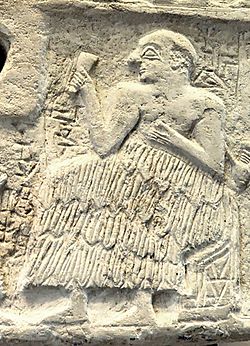
Ur-Nanshe, seated, wearing flounced skirt. The text to the right of his head reads "Ur-Nanshe" (𒌨𒀭𒀏, UR-NAN). The text in front of him reads "Boats from the land of Dilmun carried the wood" (𒈣
|
|
| Reign | c. 2550 BC – 2500 BC |
| Predecessor | Lugal-sha-engur |
| Successor | Akurgal |
| Spouse | Abda? Menbara-abzu |
| Issue | Akurgal, Lugal-ezem, Anekura, Mukur...ta, Anunpa, Menusu, Adatur |
| Dynasty | 1st Dynasty of Lagash |
| Father | Gunidu |
Ur-Nanshe (also called Ur-Nina) was the very first king of the First Dynasty of Lagash. This was an ancient city-state in Sumer, a region in ancient Mesopotamia. He ruled around 2500 BCE, which was a long, long time ago!
Ur-Nanshe is famous for many things. He ordered the building of many important structures, like canals and temples, in his kingdom of Lagash. He also worked hard to protect Lagash from its rival city, Umma. Even though he was a powerful king, he probably wasn't born into a royal family. His father, Gunidu, didn't have a royal title. Ur-Nanshe's son, Akurgal, became king after him. His grandson, Eanatum, continued his work. Eanatum even made Lagash bigger by defeating Umma, as shown on the famous Stele of the Vultures.
Contents
Building Projects and Temples
Ur-Nanshe was a great builder. He built many temples for the gods and goddesses of Sumer. These included temples for Ningirsu in Girsu, and for Nanshe in Nina. He also built a temple called Apsubanda.
One important temple he built was the Ibgal of Inanna. This temple was later fixed up by his grandson Eanatum. The Ibgal of Inanna was located in the ancient city of Lagash, which is now called al-Hiba. It was surrounded by an oval wall and made of mud bricks. It's interesting because this temple was built on the edge of the city, not in the center like most temples in ancient Sumer.
Inscriptions and Artworks
Ur-Nanshe left behind many inscriptions and stone carvings. These artworks show him, his family, and people from his royal court. They help us learn about his life and what he did.
The Perforated Relief
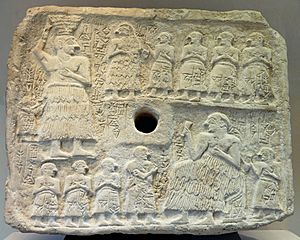
One famous artwork is the Perforated Relief of King Ur-Nanshe. You can see it at the Louvre Museum in Paris. This relief shows the king as a builder of temples and canals. This means he was seen as someone who kept order and peace, given to him by the gods.
The relief is a flat piece of limestone with holes in it. It was probably part of a wall decoration. It has writing in Sumerian that says:
“Ur-Nanshe, king of Lagash, son of Gunidu, son of Gurmu, built the temple of Ningirsu, built Apsubanda, built the temple of Nanshe.”
The carving has two parts, one above the other. Both show Ur-Nanshe as king. In the top part, he wears a special wool skirt called a kaunakes. He carries a basket of bricks on his head, showing he is building. Around him are his wife and seven of his sons. Names are written on their clothes to identify them.
In the bottom part, Ur-Nanshe is at a big party. This party celebrates the building of the temple. He sits on a throne, wearing the same outfit. Other court members are around him. In both parts, Ur-Nanshe is shown much larger than everyone else. This is a way of showing how important he was.
A part of the writing on the relief says: “Boats from the (distant) land of Dilmun carried the wood (for him)”. This is the oldest known record of Dilmun. It also shows that goods were brought into Mesopotamia from far away lands.
Door Socket Inscription
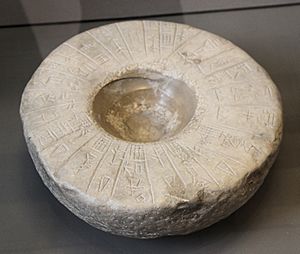
Another important item is an inscribed door socket from Ur-Nanshe. It is also in the Louvre Museum. A door socket is a stone that a door pivot would rest in, allowing it to swing open and closed. The writing on it tells us more about his building projects:
"Ur-Nanshe, the king of Lagash, the son of Gunidu, the son of Gurmu, built the house of Ningirsu; built the house of Nanshe; built the house of Gatumdug; built the harem; built the house of Ninmar. The ships of Dilmun brought him wood as a tribute from foreign lands. He built the Ibgal; built the Kinir; built the scepter (?)-house."
-
This inscription on the door socket also mentions: "The ships of Dilmun, from the foreign lands, brought him (Ur-Nanshe) wood as a tribute."
The Plaque of Ur-Nanshe

The Plaque of Ur-Nanshe is another limestone carving at the Louvre Museum. It honors Ur-Nanshe. The figures on it, including the king and his court, stand stiffly with wide eyes. They are showing respect to the goddess Nanshe. They wear kaunakes and hold their hands together over their chests. Just like the Perforated Relief, the king is shown larger than others. The names of the people are written on them using cuneiform writing.
The inscription on this plaque says:
“Ur-Nanshe, king of Lagash, son of Gunidu, built the temple of Ningirsu”
Other Inscriptions
Many other inscriptions have been found that mention Ur-Nanshe. Some of these are lists of rulers of Lagash. Others are hymns, which are like songs or poems praising a god or goddess.
For example, a list of rulers says: “Ur-Nanše, the son of ......, who built the E-Sirara, her temple of happiness and Niĝin, her beloved city, acted for 1080 years. Ane-tum, the son of Ur-Nanše”
And a hymn to the goddess Nanshe says: “There is perfection in the presence of the lady. Lagaš thrives in abundance in the presence of Nanše. She chose the šennu in her holy heart and seated Ur-Nanše, the beloved lord of Lagaš, on the throne. She gave the lofty scepter to the shepherd.”
-
A small statue used as a temple foundation. It says: "Ur-Nanshe, King of Lagash, has built the shrine of Girsu." It's in the British Museum.
See also
 In Spanish: Ur-Nanshe para niños
In Spanish: Ur-Nanshe para niños



